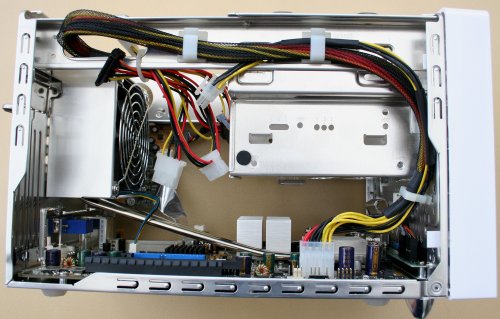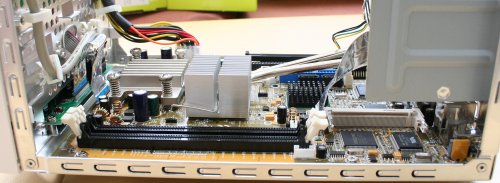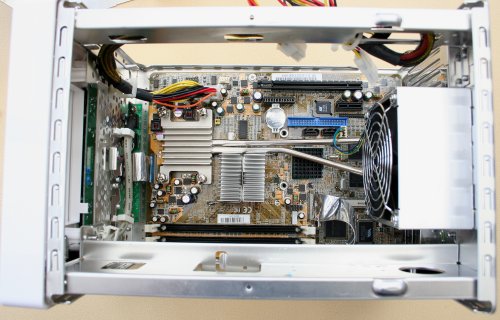Internals I

Removing the cover shows that the SD11G5, in common with other G5 XPCs, isn't a completely tool-less assembly. A couple of small screws need to be removed so that the drive tray can be taken out. Note the lack of an internal PSU here, too. Also, when compared to the roomier P-series chassis, a multicard reader is conspicuous by its absence.

Taking a look at one side shows just how it's all put together. The cooler is far enough back to mount an optical drive in the tray, which can hold a single 5.25" and a couple of 3.5" drives concurrently, without any problems. You can also spy the heatpipe-driven CPU cooler, as well as the single x16 PCIe slot and single ATA100 port. Shuttle, on this occasion, doesn't pre-route any cabling inside the chassis.

A couple of 240-pin DIMM slots means that you can run up to 2GB of unbuffered DDR2 RAM that, in conjunction with the i915GM/ICH6M chipset combination, opens up the possibility of dual-channel running with DDR2-533 memory speeds. Couple that in with the excellent comparative performance from Intel's S479 line of CPUs and you have the makings of quiet box that can be made deceptively powerful.
A closer look also shows a couple of interesting features that are grouped on the right-hand side. The first is a laptop-like mini-PCI slot, allowing you to add in, say, Wireless connectivity once the card is plugged in and attached to an antenna. The second feature arrives in the form of decent audio, thanks to Shuttle specifying Creative's SoundBlaster Live 24-bit DSP. Beats the pants out of non-HD onboard audio. The grey shape on the right-hand side is the audio daughtercard whose connections we saw on the back.

Removing the drive cage shows us this vista. Click on the picture for a larger version and you'll see that Shuttle adds in a couple of non-RAIDable SATA150 ports from the Intel ICH6M southbridge, situated right below and clad in a black heatsink. USB 2.0 is an on-chip affair but FireWire400 and Gigabit Ethernet are provided by discrete ASICs from VIA and Broadcom, respectively. The cooling apparatus dominates the central portion. Thinking about it again, it's handy that the Clear CMOS button is located on the rear of the chassis, considering how congested the internals, once outfitted with the usual components, can get.









